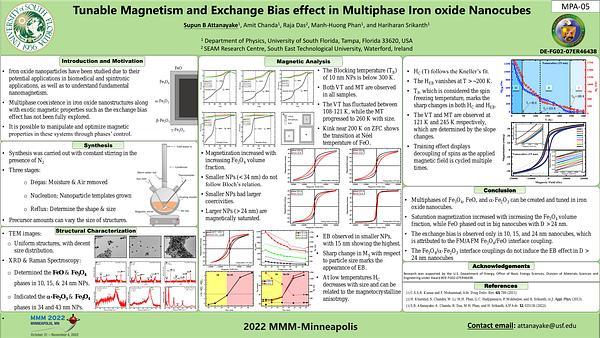Would you like to see your presentation here, made available to a global audience of researchers?
Add your own presentation or have us affordably record your next conference.
When two materials are brought into close proximity, the magnetic proximity effects, including the exchange anisotropy, exchange bias (EB), and coercivity, are among the
most fascinating and active materials research areas today. Among them, the interlayer exchange coupling (IEC) plays a crucial role to manipulate the magnetic hysteresis loop in a variety
of solid-state magnetic heterostructures. Such IEC can be understood by the equilibrium field-like spin torque (FLST) of magnetic tunnel junctions (MTJs) in noncollinear magnetic
configuration. Recently, electrical and spin switches across a single organic molecule connecting ferromagnetic electrodes are also burgeoning fields for possible applications in the socalled
molecular spintronics. The ability to calculate the noncollinear spin torque effect and spin dynamics of magnetic heterostructures is difficult but important to include the complex
structural, electronic, and magnetic properties at spinterfaces for nanoscale spintronics devices.
In this study, the molecular scale magnetic proximity effect is proposed in single-molecule magnetic junctions (SMMJs) consisting of an amine-ended 1,4-benzenediamine (BDA) molecule
coupled to two ferromagnetic Co electrodes. The magnetotransport calculation is carried out using the generalized Landau-Lifshitz-Gilbert (LLG) equation combined with density
functional theory (DFT) and our self-developed JunPy calculated spin-torque effect. We first demonstrate that the equilibrium FLST plays a crucial role in the strain-controlled exchange
bias with current-controlled magnetic coercivity in single-molecule magnetic junctions 1. In consideration of the resonant tunnelling and the multi-reflection processes at interfaces, our
DFT+JunPy+LLG calculation results 2,3 illustrate the underlying mechanism in an important aspect, namely, molecular scale exchange bias effect, via the modulation of angular
dependence of equilibrium FLST in amine-ended SMMJs with complex contact deformation and interfacial bonding during breaking junction techniques. This work is supported by the
Ministry of Science and Technology (108-2628-M-008-004-MY3).
References:
1 Y. -H. Tang and B. -H. Huang, Phys. Rev. Research 3, 033264 (2021)
2 K. -R. Chiang and Y. -H. Tang, ACS Omega 6, 19386 (2021)
3 Y. -H. Tang, Y. -C. Chuang, and B. -H. Huang, submitted to Front. Phys. : Charge, Heat and Spin Transport Through Molecular Nanostructures
